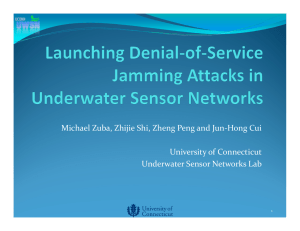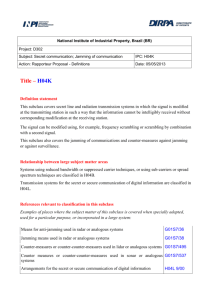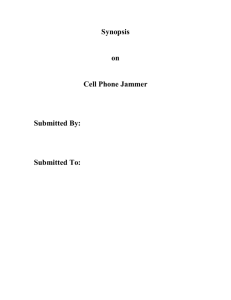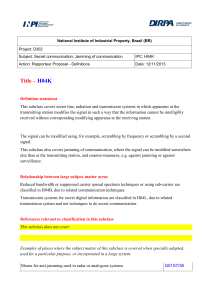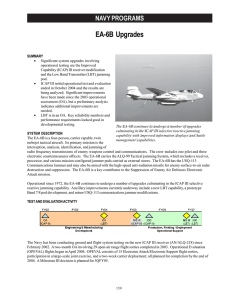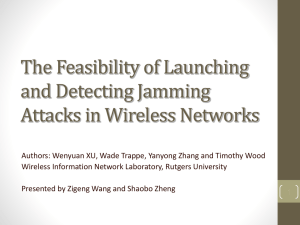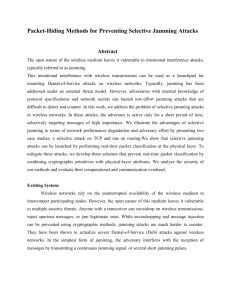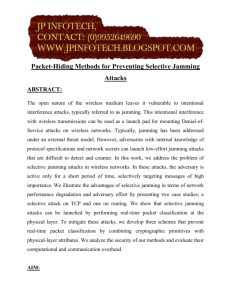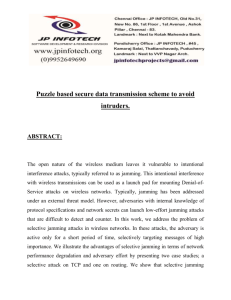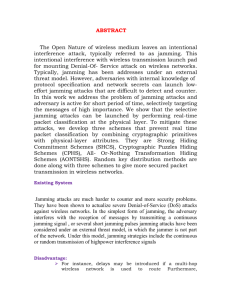Defeating Jamming With the Power of Silence: A
advertisement
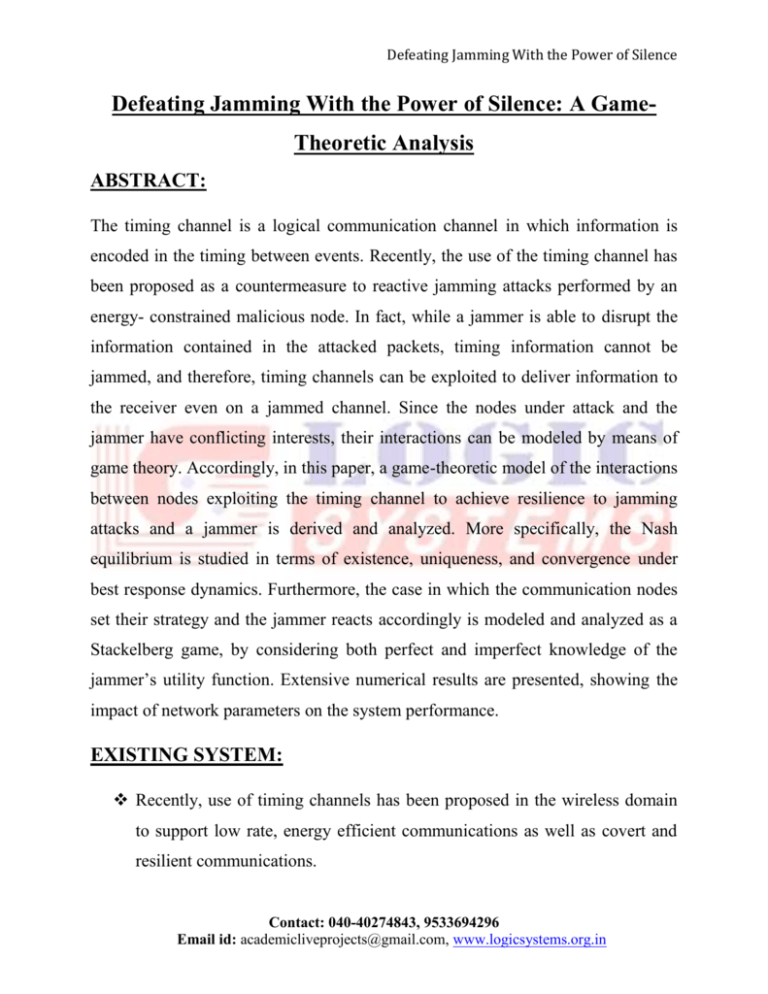
Defeating Jamming With the Power of Silence Defeating Jamming With the Power of Silence: A GameTheoretic Analysis ABSTRACT: The timing channel is a logical communication channel in which information is encoded in the timing between events. Recently, the use of the timing channel has been proposed as a countermeasure to reactive jamming attacks performed by an energy- constrained malicious node. In fact, while a jammer is able to disrupt the information contained in the attacked packets, timing information cannot be jammed, and therefore, timing channels can be exploited to deliver information to the receiver even on a jammed channel. Since the nodes under attack and the jammer have conflicting interests, their interactions can be modeled by means of game theory. Accordingly, in this paper, a game-theoretic model of the interactions between nodes exploiting the timing channel to achieve resilience to jamming attacks and a jammer is derived and analyzed. More specifically, the Nash equilibrium is studied in terms of existence, uniqueness, and convergence under best response dynamics. Furthermore, the case in which the communication nodes set their strategy and the jammer reacts accordingly is modeled and analyzed as a Stackelberg game, by considering both perfect and imperfect knowledge of the jammer’s utility function. Extensive numerical results are presented, showing the impact of network parameters on the system performance. EXISTING SYSTEM: Recently, use of timing channels has been proposed in the wireless domain to support low rate, energy efficient communications as well as covert and resilient communications. Contact: 040-40274843, 9533694296 Email id: academicliveprojects@gmail.com, www.logicsystems.org.in Defeating Jamming With the Power of Silence In existing system methodologies to detect jamming attacks are illustrated; it is also shown that it is possible to identify which kind of jamming attack is ongoing by looking at the signal strength and other relevant network parameters, such as bit and packet errors. Several solutions against reactive jamming have been proposed that exploit different techniques, such as frequency hopping, power control and unjammed bits. DISADVANTAGES OF EXISTING SYSTEM: Continuous jamming is very costly in terms of energy consumption for the jammer Existing solutions usually rely on users’ cooperation and coordination, which might not be guaranteed in a jammed environment. In fact, the reactive jammer can totally disrupt each transmitted packet and, consequently, no information can be decoded and then used to this purpose. PROPOSED SYSTEM: In this paper we focus on the resilience of timing channels to jamming attacks. In general, these attacks can completely disrupt communications when the jammer continuously emits a high power disturbing signal, i.e., when continuous jamming is performed. In this paper we analyze the interactions between the jammer and the node whose transmissions are under attack, which we call target node. Specifically, we assume that the target node wants to maximize the amount of information that can be transmitted per unit of time by means of the Contact: 040-40274843, 9533694296 Email id: academicliveprojects@gmail.com, www.logicsystems.org.in Defeating Jamming With the Power of Silence timing channel, whereas, the jammer wants to minimize such amount of information while reducing the energy expenditure. As the target node and the jammer have conflicting interests, we develop a game theoretical framework that models their interactions. We investigate both the case in which these two adversaries play their strategies simultaneously, and the situation when the target node (the leader) anticipates the actions of the jammer (the follower). To this purpose, we study both the Nash Equilibria (NEs) and Stackelberg Equilibria (SEs) of our proposed games. ADVANTAGES OF PROPOSED SYSTEM: We model the interactions between a jammer and a target node as a jamming game We prove the existence, uniqueness and convergence to the Nash equilibrium (NE) under best response dynamics We prove the existence and uniqueness of the equilibrium of the Stackelberg game where the target node plays as a leader and the jammer reacts consequently We investigate in this latter Stackelberg scenario the impact on the achievable performance of imperfect knowledge of the jammer’s utility function; We conduct an extensive numerical analysis which shows that our proposed models well capture the main factors behind the utilization of timing channels, thus representing a promising framework for the design and understanding of such systems. Contact: 040-40274843, 9533694296 Email id: academicliveprojects@gmail.com, www.logicsystems.org.in Defeating Jamming With the Power of Silence SYSTEM ARCHITECTURE: SYSTEM REQUIREMENTS: HARDWARE REQUIREMENTS: System : Pentium IV 2.4 GHz. Hard Disk : 40 GB. Floppy Drive : 1.44 Mb. Monitor : 15 VGA Colour. Mouse : Logitech. Ram : 512 Mb. SOFTWARE REQUIREMENTS: Operating system : Windows XP/7. Coding Language : C#.net Contact: 040-40274843, 9533694296 Email id: academicliveprojects@gmail.com, www.logicsystems.org.in Defeating Jamming With the Power of Silence Tool : Visual Studio 2010 Database : SQL SERVER 2008 REFERENCE: Salvatore D’Oro, Student Member, IEEE, Laura Galluccio, Member, IEEE, iacomo Morabito, Sergio Palazzo, Senior Member, IEEE, Lin Chen, Member, IEEE, and Fabio Martignon, Member, IEEE, “Defeating Jamming With the Power of Silence: A Game-Theoretic Analysis”, IEEE TRANSACTIONS ON WIRELESS COMMUNICATIONS, VOL. 14, NO. 5, MAY 2015. Contact: 040-40274843, 9533694296 Email id: academicliveprojects@gmail.com, www.logicsystems.org.in
